

See The Victor issue 663 (3rd November 1973) to issue 673 (12th January 1974). And The Victor annual 1975. (Twelve stories in total).
Writer:- The Victor editorial team. Artists:- Josep Marti, issues 663 to 669 and the 1975 annual; artist for issues 670 to 673 Albert Holroyd.
Main cast:- Sergeant Fred Kay; Privates Tommy Jenkins; Pete Maloney; Johnny Rana; Tak Ho; Sam Pine; Colonel Grant Quartermaster, in charge of the U.S. Army Supply Stores.
Time period:- Burma mid to late 1944, World War Two.
(Note - this strip has nothing to do with the series, Danny Dixon's Crazy Railway, which also featured in The Victor).
Fred Kay’s Crazy Railroad is a World War Two comedy drama set in Burma (present day Myanmar). See the map below.

The Allies had by late 1944 invaded the country from India and were pushing Japanese forces southwards back towards Malaya. The town of Myitkyina had been liberated and the new front line was to the south around Naba. British soldiers, Sergeant Kay and Private Tommy Jenkins of the Royal Electrical and Mechanical Engineers are in charge of running British supply trains between the two towns via the railway line. (Supplies were also travelling via an American purpose built road constructed by troops under the command of General Stilwell. More on this below).
The Japanese have successfully blown up four supply trains. With no other steam engines available Kay has to resort to converting a couple of jeeps to travel on the railway tracks. (This was done by adapting the vehicle’s wheels so they could run on the railway lines). Unfortunately, the train is ambushed and one of the jeeps destroyed and several of his men shot. In order to keep his supply train moving Kay and Jenkins need to find alternative method of transporatation and a new crew. They solved the latter problem by rounding up four soldiers who had just been released from hospital and are awaiting assignment to a unit. The four new members of crew are:-
Private Johnny Rana (Gurkha) - a typical, resourceful soldier, full of energy and if given the order would set about trying to clear the Japs out of Burma single handed.
Private Sam Pine (a West Indian), who is accident prone.
Private Pete Maloney (an American), who in civilian life was a railway engine driver.
Private Tak Ho (a Chinese soldier), who likes to quote Confucius style sayings, but not sayings that the Chinese thinker would recognise! (Chinese troops operated with the Allies in Burma).
Colonel Grant - A cigar chomping American Army Quartermaster in charge of the U.S. Supply depot at Myitkyina. Both Grant and Kay are keen to be 'one up on the other man'. The two men don't hate each other, they just see the other man as a rival. If the occasion demands it though, the two men can and do work together.
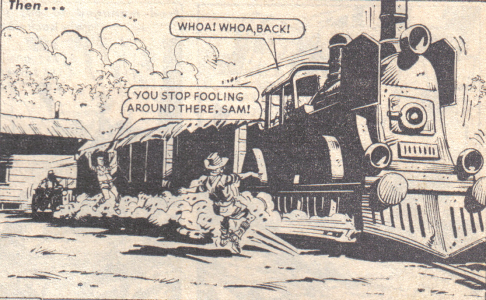
The British Army might not have had any spare vehicles, but a nearby American Supply depot does. However, Grant is not disposed to assist Kay and his men. So Kay sets about ‘liberating’ a lorry by convincing a U.S. transport driver that his ammunition truck has caught fire and then blown up. In fact, they substitute a badly damaged truck for the driveable lorry and blow up the former vehicle. Having quickly changed the wheels on the ‘liberated’ lorry our heroes set off with their first railway delivery to Naba. They are however, quickly pursued by Colonel Grant, who realises that his driver has been conned and his outfit is short of one truck.
The first two episodes concentrate on Kay doing his best to stay one step ahead of the American colonel. Eventually, the Sergeant throws Grant off the scent by disguising the truck to look like a steam train. (See the image at the beginning of this page). The truck underwent an intensive re-building programme, in the 'Railway’s engine shed'. Add in the hotch-potch of soldiers/railwaymen of different nationalities and the title of this strip makes a bit more sense.
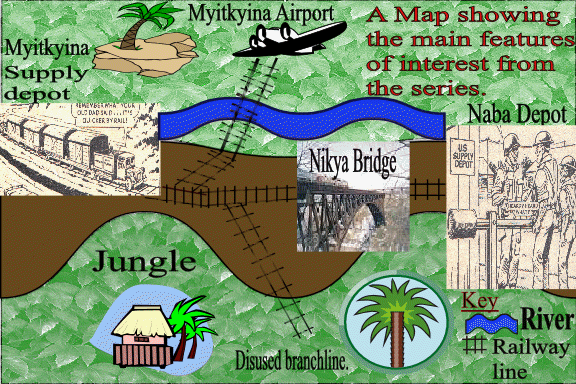
The remaining episodes of this excellent short series, tended to revolve around either Grant or Kay trying to get one over the other, tangling with enemy forces and a couple of stories revolving around individuals that the railway come into contact with. Sadly, all good things come to an end and in the final episode, Kay finds out that the front line has moved beyond Naba and that the Supply depot has also moved southwards. This effectively puts the Railway out of business. However, on their final run to Naba, they notice that a Japanese gunboat moving up river will cause havoc if it comes into contact with the Allied forces currently crossing the river further upstream. Determined to stop the gunboat, Kay at the right moment sends the train over the edge of the cliff where it strikes and sinks the vessel. Thus ends the story of Fred Kay’s Crazy Railroad. The final scene sees Kay and his men in charge of a new ferry landing craft service. See the image below, from issue 673.
This is another great series with well scripted stories and artwork. The two comic artists styles' are different, but I think they compliment each other perfectly. (Note - a jeep converted to run on railway lines was also used in one episode of Special Squad, published in The Hornet, issue 364).
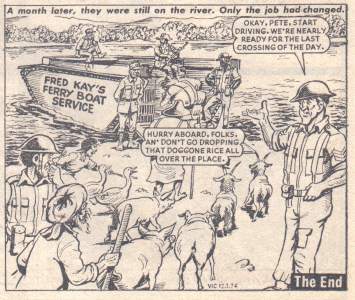
Above artwork by Albert Holroyd.
British forces were pushed out of Singapore in February 1942 northwards through Burma by the invading Japanese forces. A british soldier, Fred Millem who was working on the railway in Singapore and escaped to India in 1942, mentions passing through Naba and Myitkyina via the railway. This diary extract is from the British Broadcasting Corporation's (B.B.C.), WW2 Peoples War pages.
PART 7 The Railway Transport Operations (RTO), Mandalay, late 1941/1942.
'I do not propose to bore you with what the duties of an RTO are. They are many and varied, and the job is extremely interesting. I was to learn the ropes from and assist another young subaltern called Mayhew, and actually I was only supposed to be temporary until the arrival of a Captain fellow who was supposed to be on his way to take over at Mandalay with Mayhew as his assistant. With the railway south of Thazi in enemy hands, Mandalay station was the busiest and most important station on the whole of the Burma Railways system, and Mayhew and I were accordingly kept mighty busy. We had a staff of one sergeant, a night clerk and a couple of couriers. The railways were then being used almost entirely for military purposes and were functioning more or less normally, although they were very short staffed, a great number of the staff having already run away.'
'I soon settled down to my new job and began to thoroughly enjoy it, although the work was extremely hard and the hours long. One of our greatest difficulties was to stop looting on and around the station and another was to dispose of corpses. Mandalay was badly afflicted with a cholera epidemic and its victims invariably seemed to choose the station to die on. We were seldom without two or three bodies lying around and, needless to say, I was not long before getting a cholera inoculation.'
For the full article please use the following link. Rangoon Battalion by Fred Millem, part seven.
The story continues with the British in full retreat. From Rangoon Battalion by Fred Millem - The Monywa Picnic - Part 10 by Patricia Pringle. Article ID: A8063769. (Again from the B.B.C.'s WW2 Peoples War pages.
'Back we went to the railway station where we arrived just in time to get the news that there was no hope of getting a train up from Shwebo as the line was blocked just north of Shwebo. The only chance was to get a train from Kanbalu, about 60 miles north, to come south and pick up the party. Again we were advised to get to India under our own steam if we possibly could. Jack and I with six other officers decided that we had had enough of the AHQ party which had led us only from one bombing to another so we made up our minds to strike out on our own. We reckoned that our best chance was to get to Kanbalu in the hope that we could find a train there to go northwards. The problem was, how to get to Kanbalu which was about 60 miles away. There was no proper road and we felt rather too tired to walk it.'
'It was then that we had our first bit of good luck. We met an officer whom Jack Villiers knew, a Captain Oscar Milton, who from somewhere had obtained a Ford station wagon and was determined to drive it to Kanbalu over a bullock cart track. He already had twenty of his own men in the thing but we nevertheless persuaded him to take the eight of us. Looking back on it, it seems inconceivable how we managed to cram 28 bodies into a station wagon which was designed to carry 8. We threw out the seats and jammed ourselves in one on top of the other and off we went. It was an amazing journey Several times we all had to get out and push the car over bad bits of road and then we would be faced with the complicated job of getting all of us inside the wretched thing again. On the way the sides of the vehicle burst open and the mudguards fell off but on we went. After a halt at a village about half way where we managed to get some food we finally arrived at Kanbalu some time after dark.'
'There we found several trains waiting to go northwards. The whole line up to Myitkyina was absolutely blocked and congested. There had just been another terrific rail crash at Naba which was holding everything up and the whole situation was one of utter chaos. However, we ascertained which train was leaving first and we all managed to get a few square inches of floor space in a mail wagon wherein we started our slow journey northwards.'
'I arrived in India from Burma in good health and unscathed after being on active service throughout the entire Burma campaign.'

The above picture was taken by George Rodger, an American photographer for LIFE magazine in Burma 1942. The picture of Myitkyina railway station was published in the August 10, 1942 LIFE magazine. Note copyright 1942 Time, Inc.
Did the Allies make use of a railway line to carry supplies between Myitkyina and Naba? Well, apparently the answer is yes! (Although, disguising a truck by turning it into a 'train' didn't happen. The Jeep Railway was seen as an easy and quick solution to transporting supplies around the country). A trawl on the www produced the following information from the Burma Star Association website -
At that time, however, the American railway battalion of Northern Combat Area Command had partially restored the line and the so called “Jeep Railway” was up and running as far as Moguang, some thirty miles south. The American engineers had fitted flanged metal wheels to standard road going jeeps. The jeeps, then positioned at each end, pulled and pushed a number of hastily constructed flat bed wagons. After hitching a ride, it was quite an experience clinging on to anything that came to hand, bombing along at all of thirty miles an hour, forty with a following wind!!, and being entertained by an American escort, blazing away with their semi-automatics at everything that moved in the surrounding jungle.
The “Jeep Railway” was to prove invaluable in the following months to the British 36th Division, of which I was a member in the advance south.' (Copyright Norman Morse).
To read further extracts from Mr. Morse's memories about the Burma campaign, please visit the Burma Star Association.
Supplies also ran along a road especially built by the American army (which also included Canadian lumberjacks), known as Burma's Stilwell Road. An article about the road appeared in the 30th December 2008, Los Angeles Times.
Below is another view of a Jeep Railway, no date or title. The image was sent to me by Steve Fogden, who found the image on the www. Copyright not known. Thank you.

The Imperial War Musuem in London also holds two views of a British Army jeep railway. Type in SE 3615 or SE 2870 in the reference number box to view the photographs.
(Just a thought, but if the Americans and the British were operating railway jeeps in the same area, I wonder what sort of signalling was in operation?)
In the stories below, a rather too cheerful Colonel Grant has given Kay an explosive situation to deal with; an escaped American P.O.W. soldier rescued by the Sergeant Kay spends sometime with him and his men (issue 672), and the story about what happens to the various owners of a Rolls Royce car, (issue 666) . (Note the first story is reproduced from the 1975 Victor annual. The strips in the annuals were printed at twice the size of the stories published in the weekly comic. Hence the slightly larger artwork. And the story looks the better for it).
 |
 |
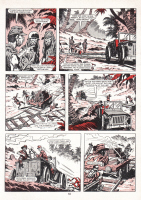 |
 |
 |
 |
 |
 |
 |
 |
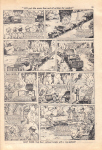 |
 |